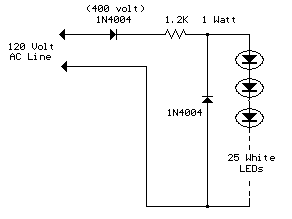
White LED Stroboscope

Finally, white LEDs are bright enough to use in a practical stroboscope. This circuit can operate as a bench-top stroboscope that, in conjunction with an oscilloscope or frequency meter and bench-top power supply, can accurately measure rotational speeds, or it can be operated hand-held from a single 9V battery, using a marked scale to estimate rotational speeds. It's a nice instrument to have on or around the workbench. Besides that, it's fun to use. Its bright enough to use without dimming the room lights and with the aid of a frequency meter or oscilloscope, can measure rotational frequency to within a few degrees per second. This LED stroboscope is a fairly simple circuit for the similarly simple task.
The described LED stroboscope circuit utilizes white LEDs due to their high brightness and efficiency, making them suitable for various applications, including the measurement of rotational speeds. The circuit can operate in two modes: a fixed bench-top configuration or a portable hand-held version powered by a 9V battery.
In the bench-top configuration, the circuit is powered by a stable bench-top power supply, which allows for precise control and measurement capabilities. The integration of an oscilloscope or frequency meter facilitates accurate readings of rotational speeds, providing valuable data for applications in mechanical engineering, automotive diagnostics, and laboratory experiments. The circuit design typically includes a microcontroller or timer IC to generate pulse signals that control the LED flashing frequency, which can be adjusted to match the rotational speed of the object being measured.
For the hand-held operation, the circuit is designed to be compact and lightweight, allowing for ease of use. A marked scale is included to help users estimate the rotational speeds visually. The 9V battery provides sufficient power for the LEDs while maintaining portability. The circuit may also incorporate a simple potentiometer to adjust the flash rate manually, enabling the user to synchronize the LED flashes with the object's rotation.
The LED stroboscope's ability to function effectively in well-lit environments is a significant advantage, as it eliminates the need for dimming lights during measurements. This feature enhances usability in various settings, making it a practical tool for both professional and hobbyist applications. The overall simplicity of the circuit design ensures that it can be built and modified easily, making it accessible for those with basic electronics knowledge.Finally, white LED`s are bright enough to use in a practical stroboscope. This circuit can operate as a bench-top stroboscope that, in conjunction with an oscilloscope or frequency meter and bench top power supply can accurately measure rotational speeds, or it can be operated hand-held from a single 9V battery, using a marked scale to estimate rotational speeds. Its a nice iinstrument to have on or around the workbench. Besides that, its fun to use. Its bright enough to use without dimming the room lights and with the aid of a frequency meter or oscilloscope, can measure rotational frequency to within a few degrees per second. This LED stroboscope is a fairly simple circuit for the similarly simple t 🔗 External reference
The described LED stroboscope circuit utilizes white LEDs due to their high brightness and efficiency, making them suitable for various applications, including the measurement of rotational speeds. The circuit can operate in two modes: a fixed bench-top configuration or a portable hand-held version powered by a 9V battery.
In the bench-top configuration, the circuit is powered by a stable bench-top power supply, which allows for precise control and measurement capabilities. The integration of an oscilloscope or frequency meter facilitates accurate readings of rotational speeds, providing valuable data for applications in mechanical engineering, automotive diagnostics, and laboratory experiments. The circuit design typically includes a microcontroller or timer IC to generate pulse signals that control the LED flashing frequency, which can be adjusted to match the rotational speed of the object being measured.
For the hand-held operation, the circuit is designed to be compact and lightweight, allowing for ease of use. A marked scale is included to help users estimate the rotational speeds visually. The 9V battery provides sufficient power for the LEDs while maintaining portability. The circuit may also incorporate a simple potentiometer to adjust the flash rate manually, enabling the user to synchronize the LED flashes with the object's rotation.
The LED stroboscope's ability to function effectively in well-lit environments is a significant advantage, as it eliminates the need for dimming lights during measurements. This feature enhances usability in various settings, making it a practical tool for both professional and hobbyist applications. The overall simplicity of the circuit design ensures that it can be built and modified easily, making it accessible for those with basic electronics knowledge.Finally, white LED`s are bright enough to use in a practical stroboscope. This circuit can operate as a bench-top stroboscope that, in conjunction with an oscilloscope or frequency meter and bench top power supply can accurately measure rotational speeds, or it can be operated hand-held from a single 9V battery, using a marked scale to estimate rotational speeds. Its a nice iinstrument to have on or around the workbench. Besides that, its fun to use. Its bright enough to use without dimming the room lights and with the aid of a frequency meter or oscilloscope, can measure rotational frequency to within a few degrees per second. This LED stroboscope is a fairly simple circuit for the similarly simple t 🔗 External reference





